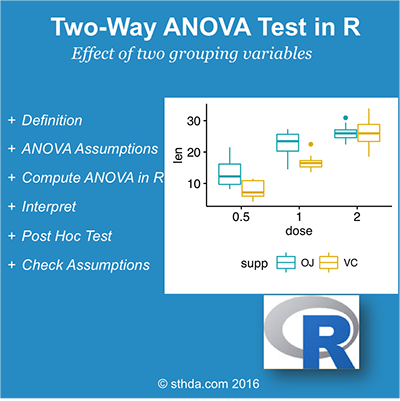
Error of measurements in astronomy was a prevalent problem of optics and other apparatus in the 18th and 19th century, and Fisher equally recognised the mess -or variance- that nature forces onto a systematic experimenter. The next big step was the provision of certainty and ways to calculate uncertainty, which came with the rise of probability statistics.įirst in astronomy, but then also in agriculture and other fields the notion became apparent that our reproducible settings may sometimes be hard to achieve. We therefore highlight that experiments are systematic. In this sense, many people consider preparing a bike without any knowledge about bikes whatsoever as a mode of “experimentation”.
#ONE WAY ANOVA EXAMPLES IN REAL LIFE TRIAL#
There was also a general tendency of experiments either working or not, which is up until today a source of great confusion, as an trial and error approach -despite being a valid approach- is often confused with a general mode of “experimentation”. Much of the early experiments were hence experiments that were rather simple but produced knowledge that was more generalisable. Necessary repetitions were conducted as well, but of less importance at that point. Laboratory conditions thus aimed at creating constant conditions and manipulating ideally only one or few parameters, which were then manipulated and therefore tested systematically. The main focus to this end was to conduct experiments that were as reproducible as possible, meaning ideally with a 100 % confidence.

Taking a shot at something or just trying out is not equal to a systematic scientific experiment.ĭue to the demand of systematic knowledge some disciplines ripened, meaning that own departments were established, including the necessary laboratory spaces to conduct experiments. The scientific method -called with the ignorant recognition of no other methods beside systematic experimental hypothesis testing as well as standardisation in engineering- hence became the motor of both the late enlightenment as well as the industrialisation, proving a crucial link between basically enlightenment and modernity. The value of systematic experiments, and consequently systematic knowledge created a direct link to practical application of that knowledge. Hence these systematic experimental approaches aided many fields such as botany, chemistry, zoology, physics and much more, but what was even more important, these fields created a body of knowledge that kickstarted many fields of research, and even solidified others. All the while Mill and others build on Bacon to derive the necessary basic debates about so called facts, building the theoretical basis to evaluate the merit of experiments. Deviating from more observational studies in physics, astronomy, biology and other fields, experiments opened the door to the wide testing of hypothesis. With the rise of disciplines in the enlightenment experiments thrived, also thanks to an increasing amount of resources available in Europe due to the Victorian age and other effects of colonialism.

Starting with Francis Bacon there was the theoretical foundation to shift previously widely un-systematic experiments into a more structured form.

Experiments are not limited to chemistry aloneĮxperiments describe the systematic and reproducible design to test specific hypothesis.


 0 kommentar(er)
0 kommentar(er)
